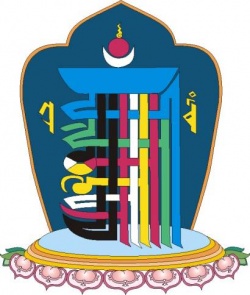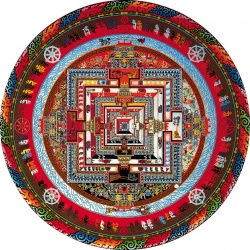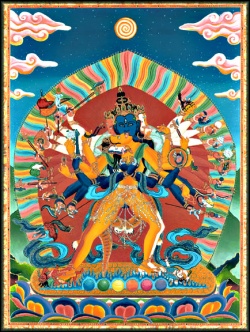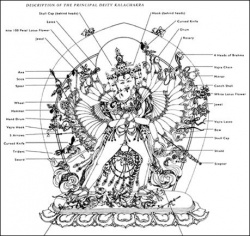Kālacakra, Sanskrit and Symbolism
Sanskrit is important to the description of Kālacakra not just because it was the original language in which the Kālacakra literature was written, but also because the Sanskrit alphabet is used as the basis of Kālacakra symbolism. The alphabet consists of vowels and consonants which are changed and combined in many different ways to give a very large variety of possible combinations and forms.
Consonants
A modern textbook on Sanskrit grammar would give a list of 25 consonants, to which a few others are added in a separate classification. The Kālacakra system is similar to the standard grammatical system, but extends it in certain ways. The discussion of the Sanskrit alphabet here follows the Kālacakra system, and therefore is not quite the same as would be found in a modern Sanskrit textbook. This system includes the following consonants:
| hard | hard aspirate |
soft | soft aspirate |
nasal | hard spirant | |
|---|---|---|---|---|---|---|
| Velar | ka | kha | ga | gha | ṅa | ḥka |
| Palatal | ca | cha | ja | jha | ña | śa |
| Retroflex | ṭa | ṭha | ḍa | ḍha | ṇa | ṣa |
| Dental | ta | tha | da | dha | na | sa |
| Labial | pa | pha | ba | bha | ma | ḥpa |
The terms voiceless and voiced are sometimes used instead of hard and soft; also guttural instead of velar, and cerebral instead of retroflex. An important point is that all these consonants are considered to have the simple vowel "a" inherent within them. This can become changed to other vowels.
As far as pronunciation is concerned, the consonants in the two columns labelled "aspirate" are equivalent to the consonants to their left but with more air breathed out. However, it is perhaps more accurate to point out that the unaspirated consonants should be truly unaspirated, and the English equivalents are more like the consonants in the right hand columns.
Guides to pronunciation can only be approximate, and so the following is given with that understanding. (Much of what follows regarding pronunciation is adapted from Michael Coulson's "Teach Yourself Sanskrit". For further details see that work or other similar textbooks.) In the first row, the nasal "ṅa" is pronounced "nga", rather like the consonant at the end of an English word such as "hang", followed by the vowel. Approximately, take the English word "hanger" and remove the first syllable.
On the second row, the "ca" and "cha" are pronounced like the English "cha", but with the former less aspirated. For this reason, the word Kālacakra is often written in English "Kalachakra". This helps those not familiar with Sanskrit to avoid pronouncing it like "Kalakakra". The "ña" on the second row is pronounced like an English "nya".
The difference between the next two rows is best understood by the site of articulation of the consonants. The "t" and "d" of the third row are more like those of English than the fourth row. For the fourth row, the tongue touches the back of the teeth, as in the English "this". For those in the third row the tongue is slightly further back, on the front of the palate, like the English "together" or "dip". A similar difference applies to the nasal syllables on these two rows.
The sibilants "śa" and "ṣa" at the ends of rows two and three are both pronounced like an English "sha", but with different placing of the tongue, with the former in the palatal position required for "ca" and "cha", and the latter in the retroflex position at the front of the palate. The dental "sa" at the end of the fourth row is pronounced like an English "sa".
In the final row it is important to remember that "pha" is an aspirated version of "pa", and is not usually pronounced like an English "fa", although this does occur in some modern usage.
Finally, the two spirants, "ḥka" and "ḥpa" are old aspirants that have long fallen from use, but are used symbolically in Kālacakra. The aspirant that is still in use is the visarga, and this is transliterated as "ḥ". This is usually understood to be pronounced with an English style "h" sound, followed by an echo of the previous vowel, So, the common "āḥ" would be pronounced "AHa", with the small "a" indicating that it is much less strong than the capital.
This visarga makes a common ending to many Kālacakra syllables, as does the anusvāra, written "ṃ", which indicates that the vowel inherent in the syllable is nasalised. This means that the syllable "hūṃ" is pronounced as "hum" or "hung".
Vowels
There are several ways of categorising the vowels. A modern Sanksrit textbook would usually list five basic vowels: a, i, ṛi, u, and ḷi. Also, a modern textbook would almost certainly not print the "i" that is shown here with ṛi and ḷi. These are used here because they make pronunciation somewhat easier for people not familiar with Sanskrit. The order of the vowels given here is also the same as found in most of the Kālacakra literature.
Each of these vowels can be lengthened, and the long vowel is represented in transliteration by a bar over it. The long vowels are therefore: ā, ī, ṛī, ū, and ḷī. The last of these never occurs in Sanskrit, but is needed for Kālacakra symbolism.
The short "a" is rather like the English "u" in "but", and the long "ā" like the English "a" in "father". It should be remembered that all the short vowels are simple vowels, not dipthongs, as are so common in English.
The short "i" is as in the English "fit", and the long "ī" as in "fee". The vowel "ṛi" is pronounced like the English "re" in "pretty", with the longer "ṝi" or "ṛī" a longer version of the same.
The short "u" is like the English "put", and the long "ū" like the English "boo". Finally, "ḷi" is like the "le" in the English "table". "ḹi" does not occur in Sanskrit texts, but would be pronounced as a longer version of "ḷi".
These vowels can undergo changes known as gradation, which implies successive strengthening of the vowels. These grades are known as guṇa and vṛiddhi. For the basic vowels, the Kālacakra system often adds a sixth in the form of aṃ, and their respective grades are:
| normal: | a | i | ṛi | u | ḷi | aṃ |
| guṇa: | a | e | ar | o | al | aḥ |
| vṛiddhi: | ā | ai | ār | au | āl | āḥ |
Another final classification that needs to be considered is the interchange between the standard five vowels and their respective semi-vowels. Again, the Kālacakra list is different from a standard Sanskrit list, which would normally only include the middle four (columns) of each of the following groups:
| Vowel: | a | i | ṛi | u | ḷi | aṃ |
| Semi-vowel: | ha | ya | ra | va | la | haṃ |
| Long vowel: | ā | ī | ṛī | ū | ḷī | aḥ |
| Long semi-vowel: | hā | yā | rā | vā | lā | hāḥ |
Symbolism
In the relationship between the different things that are categorised in the outer and inner worlds, and in "other" Kālacakra, the symbolism of the maṇḍala and deities, these vowels and consonants, on their own and in various combinations, are used to indicate the category to which something belongs. The syllables represent the quality or combinations of qualities inherent in the things being categorised.
We have seen that there are groups of four (taking the standard Sanskrit analysis), five and six sets of vowels, and the consonants are arranged in six groups of five. There are therefore many permutations possible of combinations.
Before moving on to describe more of the things that are symbolised, it is important to introduce some of the main structures discussed by Buddhism. An important concept in Buddhist theory that is central to Kālacakra symbolism is the five skandhas. These are form (gzugs, rūpa), sensation (tshor ba, vedanā), interpretation ('du shes, saṃjñā), response ('du byed, saṃskāra) and consciousness (rnam shes, vijñāna). These are components in the process of perception, and Buddhism describes this overall structure as that which is conceptually clung to as the self.
To give a very brief description of these, form is the physical structure of the sense organs and sense objects. The combination of these two produce sensations, which are then subject to interpretation, given names, associations, and so forth. The mind then produces a response to the situation, and there is a conciousness of the whole experience. As is often the case with Kālacakra, that standard list from Buddhism is increased in the Kālacakra system by the addition of a sixth skandha, that of awareness (ye shes, jñāna).
In the impure, unenlightened state, they are described in this way, but when purified, they are represented by five Buddhas, or six in the case of Kālacakra. There are also other groupings of factors within sentient experience that are treated in a similar manner. These include such things as the senses, organs and main boldily activities. Also in these lists are the five elements. The usual list is of space, wind, fire, water and earth, but in Kālacakra the list is often extended by the addition of an element of awareness, or the "empty element".
Another related set of concepts is that of the five emotional defilements ( nyon mongs, kleśa) that drive the actions of beings. Pure awareness is considered to be obscured, and when the obscurations are removed, the result is the pure state of enlightenment. There are usually considered to be two types of obscurations, conceptual and emotional. The main conceptual obscuration is the perception of the five skandhas as a self.
The emotional obscurations are bewilderment (gti mug, moha), desire ('dod chags, rāga), aversion (khong khro, dveśa), pride ( nga rgyal, māna) and jealousy (phrag dog, īrṣyā).
In the pure state these become transformed into five (pure) awarenesses, or five aspects of pure awareness. Aversion is transformed into the reality awareness (chos dbyings ye shes, dharmadhātujñāna); bewilderment the mirror-like awareness (me long ye shes, ādarśajñāna); desire the distinctness awareness (so sor rtog pa'i ye shes, pratyavekṣaṇajñāna); pride the equality awareness (mnyam nyid ye shes, samatājñāna) and jealousy becomes the accomplishing awareness (bya ba grub pa'i ye shes, kṛityānusthānajñāna).
The emotional defilements are said to be caused by the activities of the elements, which themselves are associated with the five skandhas. In the pure state the five (or six) elements are represented by the consorts of the buddhas mentioned earlier.
In this way there is a complex set of relationships between the phenomena entailed in human experience, both externally and internally, and the description of these factors in the pure state of enlightenment. Very often the symbols that are used to describe that pure state are employed in the meditation practices of Kālacakra - the goal is utilised to progress on the path.
These are the main factors that are to be dealt with in the description of the ground, path and goal of Kālacakra, and very near the beginning of the Vimalaprabhā commentary to the Kālacakra Tantra these basic categories of phenomena are set out, together with the set of syllables that symbolise them.
As is often the case with Buddhist symbolism, the two fundamental principles of method and understanding are represented in Kālacakra by the syllables e and vaṃ. There are two other syllables that have a similar function in Kālacakra, and these are more specific to the Kālacakra system itself. These are haṃ and kṣa. Pema Karpo states that all vowels arise from haṃ, or vaṃ, and all consonants from kṣa, or e. Being in essence understanding, the syllable e has the nature of emptiness, and being method, vaṃ has the nature of non-conceptual compassion. It is a fundamental point that all things can be categorised as either method or understanding. This is the first, or top level of categorisation, and there are also three and four fold classifications very commonly used, but for the purpose of understanding the symbolism used in Kālacakra, the five and six fold classes are generally more useful. These two main syllables are both considered to have the nature of two further groups of syllables: vaṃ, the five "letters of great emptiness" (stong pa chen po yi ge lnga, pañcākṣaramahāśūnya), which are the vowels: a, i, ṛi, u and ḷi, and e, the six "letters of empty potential" (thig le stong pa yi ge drug, binduśūnyaṣaḍakṣara), which are the six consonant groups: ka, ca, ṭa, ta, pa and sa.
Kālacakra describes six groups of six factors in human experience. The six skandhas are the first group, followed by the elements, senses, sense objects, bodily organs and activities. In the pure state, these are represented by various groupings of deities within the Kālacakra maṇḍala.
Mipham states that "The pure state of the six groupings within the thirty six skandhas and elements, when awareness and consciousness are counted together are known as the five 'great letters of emptiness', indicating the five awarenesses. When the elements of awareness and consciousness are treated separately, they are known as the six 'letters of empty potential'."
In the pure state, each of these groupings become:
- 6 skandhas - 6 Buddhas
- 6 elements - 6 consorts
- 6 senses - 6 Bodhisattvas
- 6 objects - 6 Bodhisattvās
- 6 organs - 6 Wrathfuls
- 6 activities - 6 consorts of the Wrathfuls
Looked at another way, each of these groups (represented by the consonants) is divided into six different classes, known by names such as Vajra, Sword, and so forth. These are associated with the vowels and the elements, the five-fold classification, in the following way:
| Earth | Water | Fire | Wind | Space | |
|---|---|---|---|---|---|
| ḷi | u | ṛi | i | a | |
| Vajra | ka | kha | ga | gha | ṅa |
| Sword | ca | cha | ja | jha | nya |
| Jewel | ṭa | ṭha | ḍa | ḍha | ṇa |
| Wheel | pa | pha | ba | bha | ma |
| Lotus | ta | tha | da | dha | na |
| Knife | sa | ḥpa | ṣa | śa | ḥka |
Taking the list of the six "letters of empty potential", we have the following. The Buddhas, Vairocana and so forth, represent the purified skandhas. Each of these is associated with a particular colour, number and direction. A full list would include the other groups of deities as the pure forms of the senses, organs, and so on.
| Vairocana | Ratnasambhava | Amitabha | Amoghasiddhi | Akṣobhya | Vajrasattva |
| Yellow | Red | White | Black | Green | Blue |
| 5 | 3 | 4 | 2 | 1 | 6 |
| ta | ṭa | pa | ca | ka | sa |
| West | South | North | East | Above | Below |
| Form | Sensation | Interpretation | Response | Consciousness | Awareness |
| ḷi | ṛi | u | i | a | aṃ |
| Earth | Fire | Water | Wind | Space | Awareness |
| ḹi | ṝi | ū | ī | ā | a |
| Body | Eyes | Tongue | Nose | Ears | Intellect |
| al | ar | o | e | a | aṃ |
| Odour | Tastes | Forms | Textures | Reality | Sounds |
| āl | ār | au | ai | ā | āḥ |
| Rectum | Hands | Legs | Voice | Vagina | Penis |
| la | ra | va | ya | ha | haṃ |
| Speech | Motion | Grasping | Defaecation | Orgasm | Urination |
| lā | rā | vā | yā | hā | haḥ |
In one sense, the six fold classification is an extension of the five fold. The main associations of the five "letters of great emptiness", their symbols, directions, elements and awarenesses, are as follows:
| Emptiness | Ultimate | Awareness | Bindu | Ultimate |
| Curved knife | Club | Visarga | Tilaka | Plowshare |
| a | i | ṛi | u | ḷi |
| Centre | East | South | North | West |
| Space | Wind | Fire | Water | Earth |
| Reality | Accomplishing | Equality | Distinctness | Mirror-like |
When this is extended to a six fold classification, both the classes of Akṣobhya and Vajrasattva are associated with the reality awareness.
E Henning




